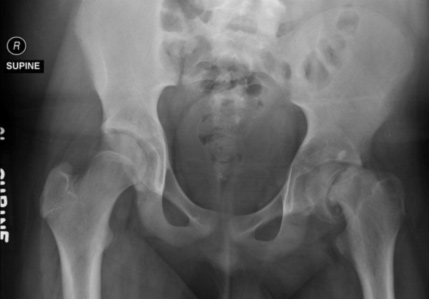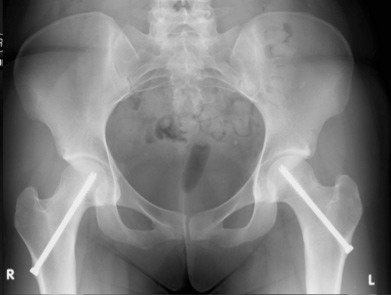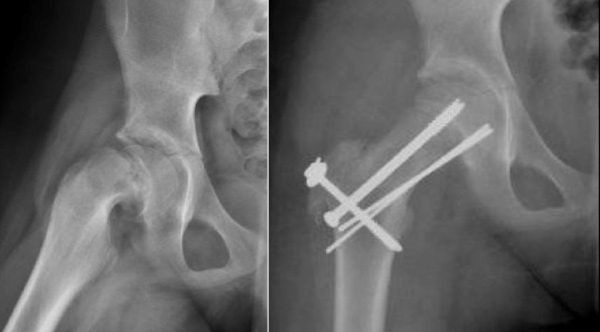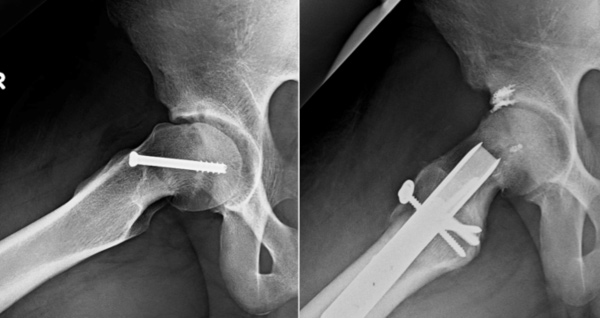The hip is a ball (femoral head) and socket (acetabulum) joint. Smooth cartilage covers the surfaces of the socket and the femoral head which allows for easy, comfortable movement of the hip. Slipped capital femoral epiphysis or SCFE (pronounced skiffy) is a disorder of the hip that occurs in adolescents when the top of the thigh bone (femoral epiphysis) slips out of place.
In children and adolescents, the bones are still developing. A growth plate (epiphyseal plate) in the femur bone (just below the femoral head) allows for the bone to lengthen as the child gets older. When the top portion of the femoral head slips off the growth plate in a backward direction, it impairs the integrity of the hip joint. The slipped epiphysis (SCFE) can cause pain, impingement, poor alignment, decreased motion and eventual osteoarthritis. Although overly simplistic, SCFE has been compared to a scoop of ice cream (top of femoral head) slipping off an ice cream cone (remainder of femur bone).

Pelvic x-ray of a 12-year-old female with a SCFE of the left hip. Note the displacement of the femoral epiphysis on the left compared to the normal right hip.
What Causes SCFE?
SCFE occurs during adolescence when the growth plates remain open. It appears that SCFE is more likely to develop during growth spurts. Boys are slightly more likely than girls to develop SCFE. This disorder is associated with adolescents who:
- Are overweight
- Have a family history of SCFE
- Have endocrine disorders (for example diabetes)
- Have kidney failure, thyroid problems or growth hormone abnormalities
Although SCFE occurs during adolescence, this disorder commonly produces a deformity that can become problematic later in life. Patients with SCFE deformities can develop pain and hip problems in their young adulthood or middle age. Joint preservation treatments can be performed both at the time of the SCFE or later in life if the slip deformity becomes problematic. Patients with a SCFE in adolescence are at risk for hip osteoarthritis later in life.
How Does SCFE Occur?
In the most typical scenario, SCFE starts gradually, but it can also have an abrupt onset. It may be the result of an accident or fall, but it is not unusual for there to be no obvious precipitating injury.
What are the Symptoms of SCFE?
Children and adolescents with SCFE may report pain in the groin, thigh, leg, or even knee rather than the hip itself. Additionally, they may develop a limp. In severe cases, it may be impossible to put any weight on the affected leg. The affected leg may also be turned outward more than the other leg. This may give the impression that one leg is longer than the other. The affected extremity is commonly shorter.
Diagnosis
Diagnosis by an expert is often needed, because SCFE is an unusual disorder. Rapid diagnosis leads to rapid treatment, which may improve outcomes. Parents who notice symptoms of pain, limping, or reduced mobility in their children should seek expert care at once.
Evaluation should include a medical history, physical examination and hip radiographs. Children with SCFE commonly do not have full range of motion in the affected hip. In some cases, they have a major loss of flexion (ability to bend the hip). Radiographs (x-rays) and other imaging techniques are required to confirm the diagnosis.
If the child can walk without crutches, SCFE is considered stable, while children who require crutches to walk have unstable SCFE. The symptoms of unstable SCFE are similar to that of a fracture in that the patient has severe pain. Ninety percent of SCFE cases are stable. Both conditions require immediate medical treatment.
Treatment
Rapid treatment of SCFE is important for optimal outcome. Most adolescents with SCFE require surgical intervention. The goal is to stabilize the growth plate (physis) so that the femoral head does not slip any further while the growth plate “closes,” that is, finishes growing. Some surgeons also emphasize deformity correction at the time the SCFE is treated. The surgical treatment of SCFE has evolved rapidly over the last 5 years and the optimal surgical treatment remains controversial. Techniques include simple screw fixation (see figure), screw fixation with deformity correction and open reduction of the slipped epiphysis. SCFE surgery can be complex, so it is recommended that you seek the experienced care of a specialist to discuss your surgical options and the most appropriate course of treatment for your child. Dr. Clohisy and his colleagues provide comprehensive care for all types of SCFE disorders.

X-ray of a 16-year-old female after successful screw fixation (“pinning”) of bilateral SCFEs.

Xrays of a severe SCFE in a 13-year-old patient (left panel). The SCFE was treated successfully with reduction and fixation (right panel).
Potential Complications
Like any hip surgery, complications can occur during the treatment of SCFE. These complications include (but are not limited to) infection, fracture, persistent pain, loss of fixation, subsequent osteoarthritis, nerve damage blood vessel injury, osteonecrosis and chondrolysis.
What to Expect from SCFE Surgery
Surgical intervention for SCFE should be prompt, so your child may be asked to report to the hospital immediately. The specific type of hip surgery will depend upon the severity of deformity, the chronicity of the SCFE and the treatment recommendations of the surgeon. Your surgeon will explain how long the procedure is expected to take and how it will be performed. After surgery, the child will be on crutches for six to eight weeks. Progressive weight bearing and return to activity will then be the focus of treatment. Recurrent hip pain can develop after the initial treatment of SCFE. Such pain should be evaluated promptly to determine if additional treatment is needed.
Restrictions Following SCFE Surgery
SCFE surgery will limit your child’s mobility and activity for two to four months. After this interval, the child will be able to walk without crutches and start to resume his or her normal activities. Children should be able to go about normal activities and exercise once they have completely recovered. Nevertheless, some patients treated for SCFE have persistent or recurrent hip pain. Such symptoms should be evaluated further to assess the SCFE deformity correction. It is important to note that patients with SCFE are at risk for hip osteoarthritis and the need for hip replacement later in life.
SCFE Facts and Figures
- In most cases, SCFE develops in only one hip; about 25% of SCFE patients have involvement of both hips
- SCFE patients are 60% boys, 40% girls
- SCFE almost never occurs in girls once menstruation has begun
- Children with SCFE are more likely to develop arthritis as adults
(Facts & Figures from Loder, R.T., Slipped Capital Femoral Ephiphysis, American Academy of Family Physicians, online at http://www.aafp.org/afp/980501ap/loder.html)
Residual SCFE Deformity
Many patients with a SCFE in adolescence have a residual deformity that can cause hip pain and eventual osteoarthritis. The residual SCFE deformity is known to cause secondary femoroacetabular impingement (FAI). Many patients with residual deformity present with hip problems between the ages of 15 and 30 years. Treatment of residual SCFE deformities can be successful in relieving pain, improving function and increasing activity level. In some patients residual SCFE deformity is associated with advanced osteoarthritis and the only effective treatment may be a total hip replacement. Reconstructive hip surgery for residual SCFE deformities can be complex and is best performed by a surgeon with specific interest and expertise in this area.

Radiographs of a residual SCFE deformity after previous pinning (left panel). The residual deformity produced problematic hip impingement which was treated with reconstructive osteotomy surgery (right panel).